The Influence of the Operator’s Perception on the Energy Demand for a Hydraulic Manipulator with a Large Working Area
Abstract
1. Introduction
2. Methods
2.1. Experimental Setting and User Task
- vs—the average effective velocity of the effector’s movement for the entire steady motion phase (PS);
- aamax—the maximum acceleration of the effector’s movement for the acceleration phase (PA);
- admax—the maximum acceleration of the effector’s movement for the deceleration phase (PD);
- ts—the average steady motion phase duration;
- ta—the average acceleration phase (PA) duration;
- td—the average deceleration phase (PD) duration.
- Acceleration phase according to the following equation:
- Deceleration phase according to the following equation:
- Acceleration phase according to the following equation:
- Steady motion phase according to the following equation:
- Deceleration phase according to the following equation:
2.2. Participants
3. Results and Discussion
- -
- The maximum accelerations in PA—aamax i PD—admax;
- -
- The power indicator in PA—Namax i PD—Ndmax;
- -
- The energy indicator in PA—Ea i PD—Ed.
- (a)
- The power indicator depends on the size ratio:
- -
- For the C1 normal movements range (α = 0.05 and RMSSE (Root Mean Square Standardized Effect) = 0.5864 and fast movements range (α = 0.05 and RMSSE = 1.0315);
- -
- For the C2 normal movements range (α = 0.05 and RMSSE = 0.7375) and fast movements range (α = 0.05 and RMSSE = 1.0937);
- -
- For the C3 normal movements range (α = 0.05 and RMSSE = 1.0167) and fast movements range (α = 0.05 fast RMSSE = 1.0289).
- (b)
- The energy indicator depends on the movement range:
- -
- For the size ratio K = 10 of normal movements (α = 0.05 and RMSSE = 0.6970) and fast movements (α = 0.05 and RMSSE = 0.4420);
- -
- For the size ratio K = 5 of normal movements (α = 0.05 and RMSSE = 0.6235) and fast movements (α = 0.05 and RMSSE = 0.5725);
- -
- For the size ratio K = 2.5 of normal movements (α = 0.05 and RMSSE = 0.5938) and fast movements (α = 0.05 and RMSSE = 0.5858).
4. Conclusions
Author Contributions
Funding
Institutional Review Board Statement
Informed Consent Statement
Data Availability Statement
Conflicts of Interest
References
- Nurmi, J.; Mattila, J. Global Energy-Optimal Redundancy Resolution of Hydraulic Manipulators: Experimental Results for a Forestry Manipulator. Energies 2017, 10, 647. [Google Scholar] [CrossRef]
- Fang, D.; Yang, J.; Shang, J.; Wang, Z.; Feng, Y. A Novel Energy-Efficient Wobble Plate Hydraulic Joint for Mobile Robotic Manipulators. Energies 2018, 11, 2915. [Google Scholar] [CrossRef]
- Zheng, S.; Ding, R.; Zhang, J.; Xu, B. Global energy efficiency improvement of redundant hydraulic manipulator with dynamic programming. Energy Convers. Manag. 2021, 230, 113762. [Google Scholar] [CrossRef]
- Ge, L.; Quan, L.; Zhang, X.; Zhao, B.; Yang, J. Efficiency improvement and evaluation of electric hydraulic excavator with speed and displacement variable pump. Energy Convers. Manag. 2017, 150, 62–71. [Google Scholar] [CrossRef]
- Zhao, L.; Yang, T.; Yang, Y.; Yu, P. A Wearable Upper Limb Exoskeleton for Intuitive Teleoperation of Anthropomorphic Manipulators. Machines 2023, 11, 441. [Google Scholar] [CrossRef]
- Chon, S.U.; Seo, J.; Kim, J.; Han, S.; Park, S.; Kim, J.T.; Kim, J.; Cho, J. Design of an Intuitive Master for Improving Teleoperation Task Performance Using the Functional Separation of Actuators: Movement and Gravity Compensation. Actuators 2022, 11, 204. [Google Scholar] [CrossRef]
- Yamakawa, Y.; Katsuki, Y.; Watanabe, Y.; Ishikawa, M. Development of a High-Speed, Low-Latency Telemanipulated Robot Hand System. Robotics 2021, 10, 41. [Google Scholar] [CrossRef]
- Zhu, J.; Liu, X.; Shi, Q.; He, T.; Sun, Z.; Guo, X.; Liu, W.; Sulaiman, O.B.; Dong, B.; Lee, C. Development Trends and Perspectives of Future Sensors and MEMS/NEMS. Micromachines 2020, 11, 7. [Google Scholar] [CrossRef] [PubMed]
- Scibilia, A.; Pedrocchi, N.; Fortuna, L. Modeling Nonlinear Dynamics in Human-Machine Interaction. IEEE Access 2023, 11, 58664–58678. [Google Scholar] [CrossRef]
- Krogul, P.; Cieślik, K.; Łopatka, M.J.; Przybysz, M.; Rubiec, A.; Muszyński, T.; Rykała, Ł.; Typiak, R. Experimental Research on the Influence of Size Ratio on the Effector Movement of the Manipulator with a Large Working Area. Appl. Sci. 2023, 13, 8908. [Google Scholar] [CrossRef]
- Cieślik, K.; Łopatka, M.J. Research on Speed and Acceleration of Hand Movements as Command Signals for Anthropomorphic Manipulators as a Master-Slave System. Appl. Sci. 2022, 1, 3863. [Google Scholar] [CrossRef]
- Si, W.; Wang, N.; Yang, C. A review on manipulation skill acquisition through teleoperation-based learning from demonstration. Cogn. Comput. Syst. 2020, 3, 1–16. [Google Scholar] [CrossRef]
- Marvel, J.; Bostelman, R. Towards mobile manipulator safety standards. In Proceedings of the IEEE International Symposium on RObotic and Sensors Environments (ROSE), Washington, DC, USA, 21–23 October 2013. [Google Scholar]
- Lichiardopol, S. A Survey on Teleoperation; DCT rapporten 2007; Technische Universiteit Eindhoven: Eindhoven, The Netherlands, 2007; Volume 2007.155. [Google Scholar]
- Lopez Pulgarin, E.J.; Tokatli, O.; Burroughes, G.; Herrmann, G. Assessing tele-manipulation systems using task performance for glovebox operations. Front. Robot. AI 2022, 9, 932538. [Google Scholar] [CrossRef] [PubMed]
- Shinde, V.B.; Pawar, P.J. Minimizing cycle time and energy consumption for a multi-degree serial manipulator using teaching–learning-based optimization. J Braz. Soc. Mech. Sci. Eng. 2023, 45, 263. [Google Scholar] [CrossRef]
- Shah, H.N.M.; Sulaiman, M.; Isa, K.S.M.; Kamis, Z.; Baharon, M.R. Optimization of Energy Consumption in KUKA KR 16 Articulated Robot Manipulator. Int. J. Recent Technol. Eng. 2019, 8, 6470–6476. [Google Scholar] [CrossRef]
- Garriz, C.; Domingo, R. Trajectory Optimization in Terms of Energy and Performance of an Industrial Robot in the Manufacturing Industry. Sensors 2022, 22, 7538. [Google Scholar] [CrossRef] [PubMed]
- Łopatka, M.J.; Rubiec, A. Concept and Preliminary Simulations of a Driver-Aid System for Transport Tasks of Articulated Vehicles with a Hydrostatic Steering System. Appl. Sci. 2020, 10, 5747. [Google Scholar] [CrossRef]
- Dąbrowska, A.; Jaskółowski, M.B.; Rubiec, A. Cameras vibrations influence on efficiency of teleoperated Unmanned Ground Vehicle. In Proceedings of the 21st International Conference on Methods and Models in Automation and Robotics (MMAR), Miedzyzdroje, Poland, 29 August–1 September 2016; pp. 772–777. [Google Scholar] [CrossRef]
- Łopatka, M.J.; Krogul, P.; Przybysz, M.; Rubiec, A. Preliminary Experimental Research on the Influence of Counterbalance Valves on the Operation of a Heavy Hydraulic Manipulator during Long-Range Straight-Line Movement. Energies 2022, 15, 5596. [Google Scholar] [CrossRef]
- Caiza, G.; Garcia, C.A.; Naranjo, J.E.; Garcia, M.V. Flexible Robotic Teleoperation Architecture for Intelligent Oil Fields. Heliyon 2020, 6, e03833. [Google Scholar] [CrossRef] [PubMed]
- Conte, D.; Leamy, S.; Furukawa, T. Design and Map-Based Teleoperation of a Robot for Disinfection of COVID-19 in Complex Indoor Environments. In Proceedings of the 2020 IEEE International Symposium on Safety, Security, and Rescue Robotics (SSRR), Abu Dhabi, United Arab Emirates, 4–6 November 2020; pp. 276–282. [Google Scholar]
- Guo, J.; Ye, L.; Liu, H.; Wang, X.; Liang, L.; Liang, B. Safety-Oriented Teleoperation of a Dual-Arm Mobile Manipulation Robot. In Intelligent Robotics and Applications, Proceedings of the 15th International Conference, ICIRA 2022, Harbin, China, 1–3 August 2022; Liu, H., Yin, Z., Liu, L., Jiang, L., Gu, G., Wu, X., Ren, W., Eds.; Springer International Publishing: Cham, Switzerland, 2022; pp. 780–792. [Google Scholar]
- Łopatka, M.J.; Muszyński, T. Future robots using in C-IED detection. In Proceedings of the 1st International Conference Challenges to Nacional Defence in Contemporary Geopolitical Situation (CNDCGS’2018), Pabrade, Lithuania, 25–27 April 2018. [Google Scholar]
- Petrenko, V.I.; Tebueva, F.B.; Antonov, V.O.; Gurchinsky, M.M. Mathematical methods for planning energy-efficient motion path of the manipulator anthropomorphic robot for the typical obstacles. IOP Conf. Ser. Mater. Sci. Eng. 2020, 919, 052055. [Google Scholar] [CrossRef]
- Ma, C.; Gao, H.; Ding, L.; Tao, J.; Xia, K.; Yu, H.; Deng, Z. Optimal Energy Consumption for Mobile Manipulators Executing Door-Opening Task. Math. Probl. Eng. 2018, 2018, 8987953. [Google Scholar] [CrossRef]
- Du, H.; Du, J.M.; Chen, L.A.; Mai, Z.W.; Liu, X.H.; Cai, H.Z. Multi-DOF Robotic Manipulator Trajectory Controlling Based on Minimum Energy Optimization. In Advances in Intelligent Systems Research; Atlantis Press: Amsterdam, The Netherlands, 2015; pp. 345–349. [Google Scholar] [CrossRef]
- Hrabar, I.; Vasiljević, G.; Kovačić, Z. Estimation of the Energy Consumption of an All-Terrain Mobile Manipulator for Operations in Steep Vineyards. Electronics 2022, 11, 217. [Google Scholar] [CrossRef]
- Khiyavi, O.A.; Seo, J.; Lin, X. Energy Saving in an Autonomous Excavator via Parallel Actuators Design and PSO-Based Excavation Path Generation. Eng. Proc. 2022, 24, 5. [Google Scholar] [CrossRef]
- Xiao, Y.; Guan, C.; Li, P.Y.; Wang, F. Optimal design of a compound hybrid system consisting of torque coupling and energy regeneration for hydraulic hybrid excavator. In Proceedings of the IEEE International Conference on Advanced Intelligent Mechatronics (AIM), Busan, Republic of Korea, 7–11 July 2015; pp. 1525–1530. [Google Scholar]
- Yu, Y.X.; Ahn, K.K. Application of hydraulic transformer on energy saving for boom system of hybrid hydraulic excavator. Appl. Mech. Mater. 2017, 868, 118–123. [Google Scholar] [CrossRef]
- Wang, W.; Chi, H.; Zhao, S.; Du, Z. A control method for hydraulic manipulators in automatic emulsion filling. Autom. Constr. 2018, 91, 92–99. [Google Scholar] [CrossRef]
- Ambar, R.B.; Sagara, S. Development of a master controller for a 3-link dual-arm underwater robot Artif. Life Robot. 2015, 20, 327–335. [Google Scholar] [CrossRef]
- Howard, I.P. Binocular Vision and Stereopsis; Oxford University Press: Oxford, UK, 1995; ISBN -13: 9780195084764. [Google Scholar]
- Zauner, J.; Broszio, K.; Bieske, K. Influence of the Human Field of View on Visual and Non-Visual Quantities in Indoor Environments. Clocks Sleep 2023, 5, 476–498. [Google Scholar] [CrossRef] [PubMed]
- Strasburger, H.; Rentchsler, I.; Juttner, M. Peripheral vision and pattern recognition: A review. J. Vis. 2011, 11, 1–82. [Google Scholar] [CrossRef]
- SAE J833; Human Physical Dimensions. SAE International: Warrendale, PA, USA, 1989.
- SAE J898; Control Locations for Off-Road Work Machines. SAE International: Warrendale, PA, USA, 1994.
- ISO 14738:2002; Safety of Machinery—Anthropometric Requirements for Design of Workstations at Machinery. International Organization for Standarization: Geneva, Switzerland, 2002; pp. 1–26.
- Kosucki, A.; Stawiński, Ł.; Malenta, P.; Zaczyński, J.; Skowrońska, J. Energy consumption and energy efficiency improvement of overhead crane’s mechanisms. Eksploat. I Niezawodn.—Maint. Reliab. 2020, 22, 323–330. [Google Scholar] [CrossRef]
- Navidi, W. ISE Statistics for Engineers and Scientists; McGraw-Hill Education: New York, NY, USA, 2023. [Google Scholar]
- Tomšik, R. Power Comparisons of Shapiro-Wilk, Kolmogorov-Smirnov and Jarque-Bera Tests. Sch. J. Res. Math. Comput. Sci. 2019, 3, 238–243. [Google Scholar]
- Salvendy, G.; Karwowski, W. Handbook of Human Factors and Ergonomics, 5th ed.; John Wiley & Sons: Hoboken, NJ, USA, 2021. [Google Scholar]
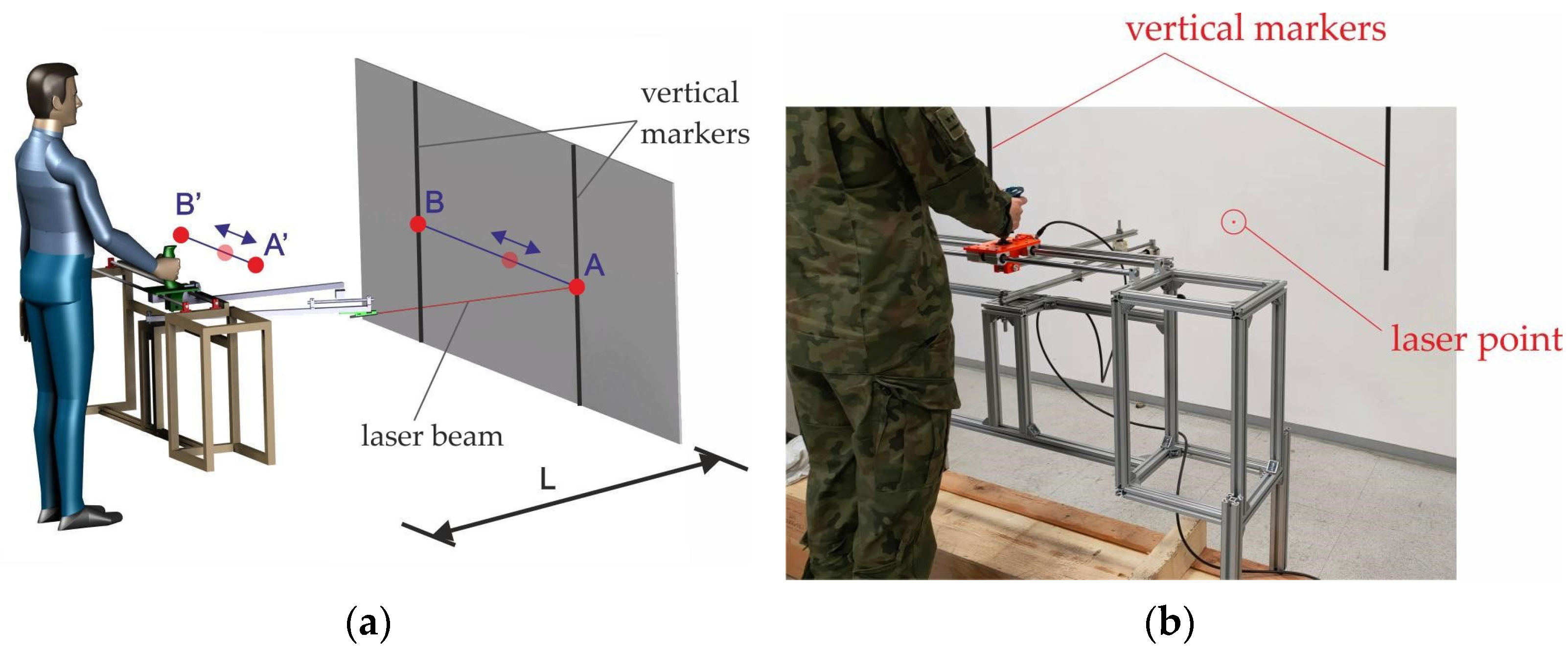
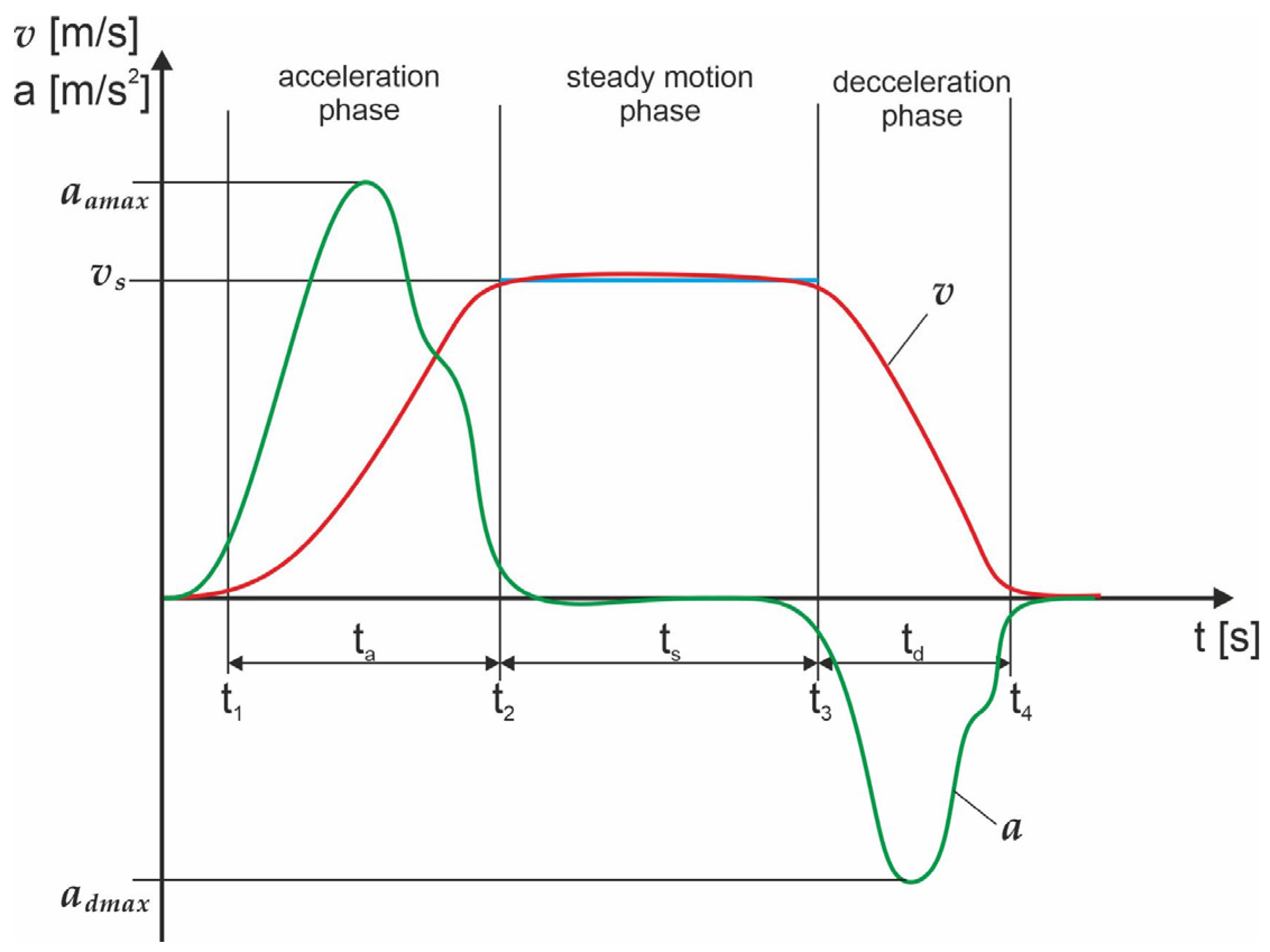
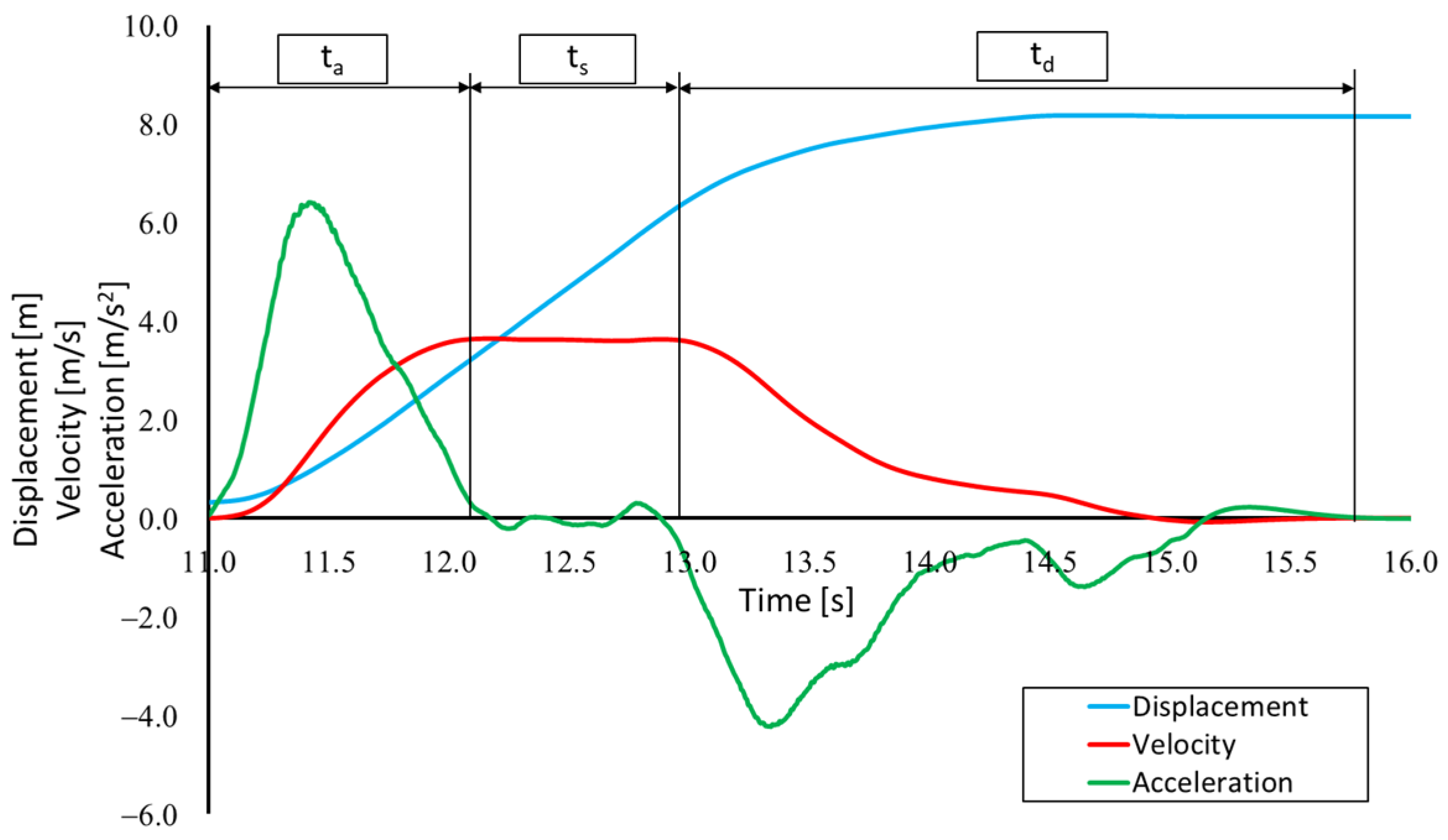
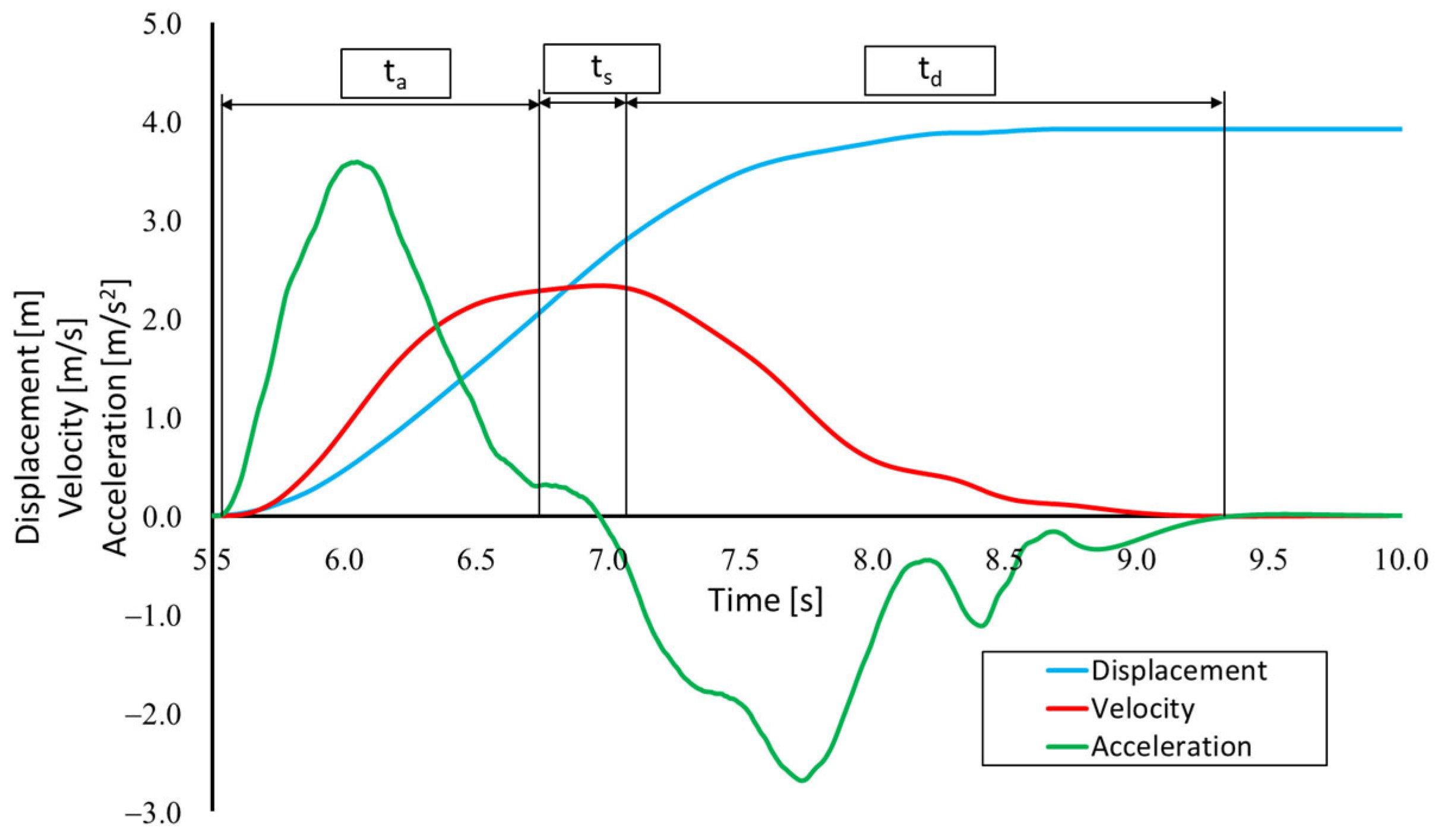

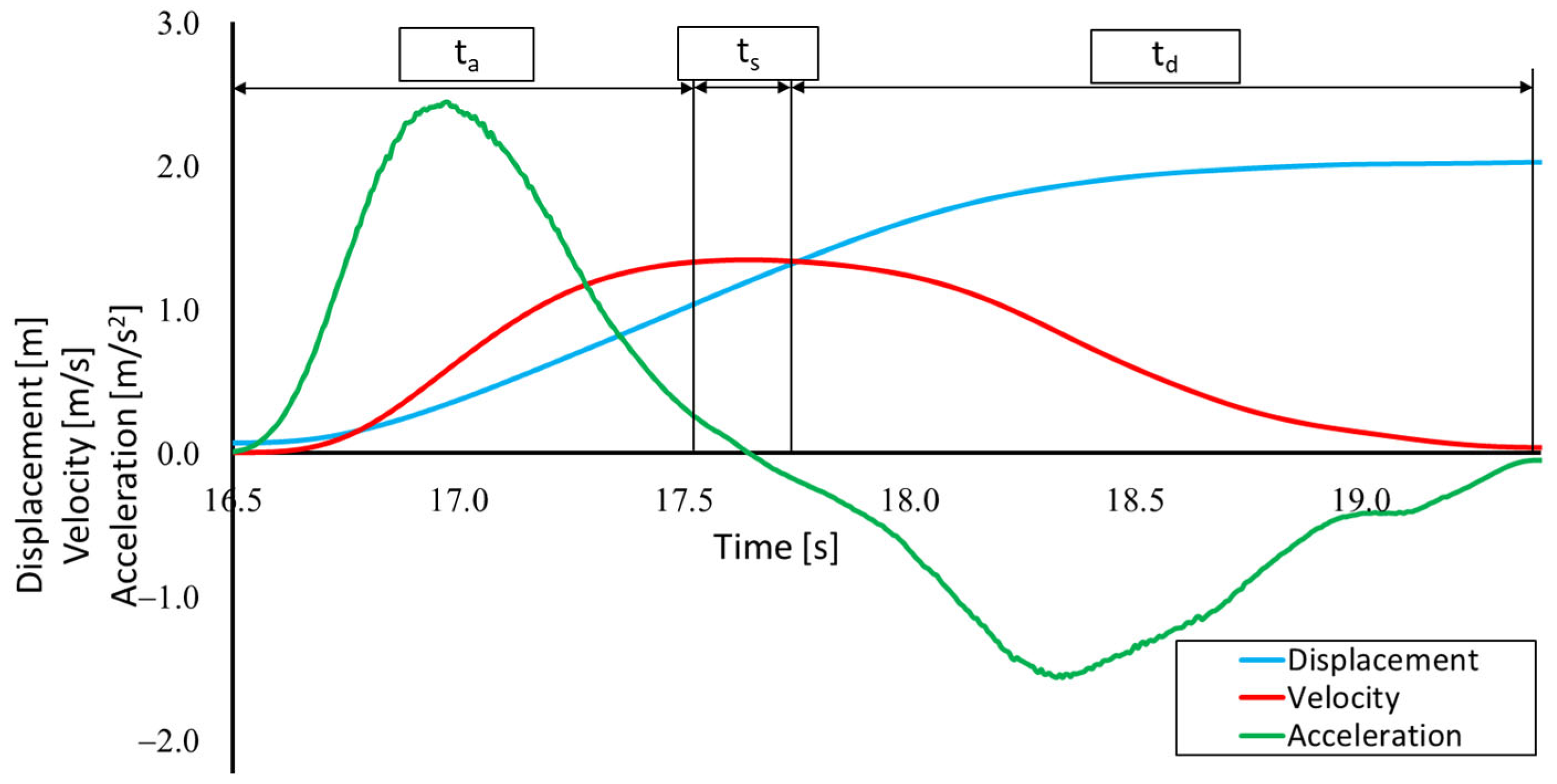


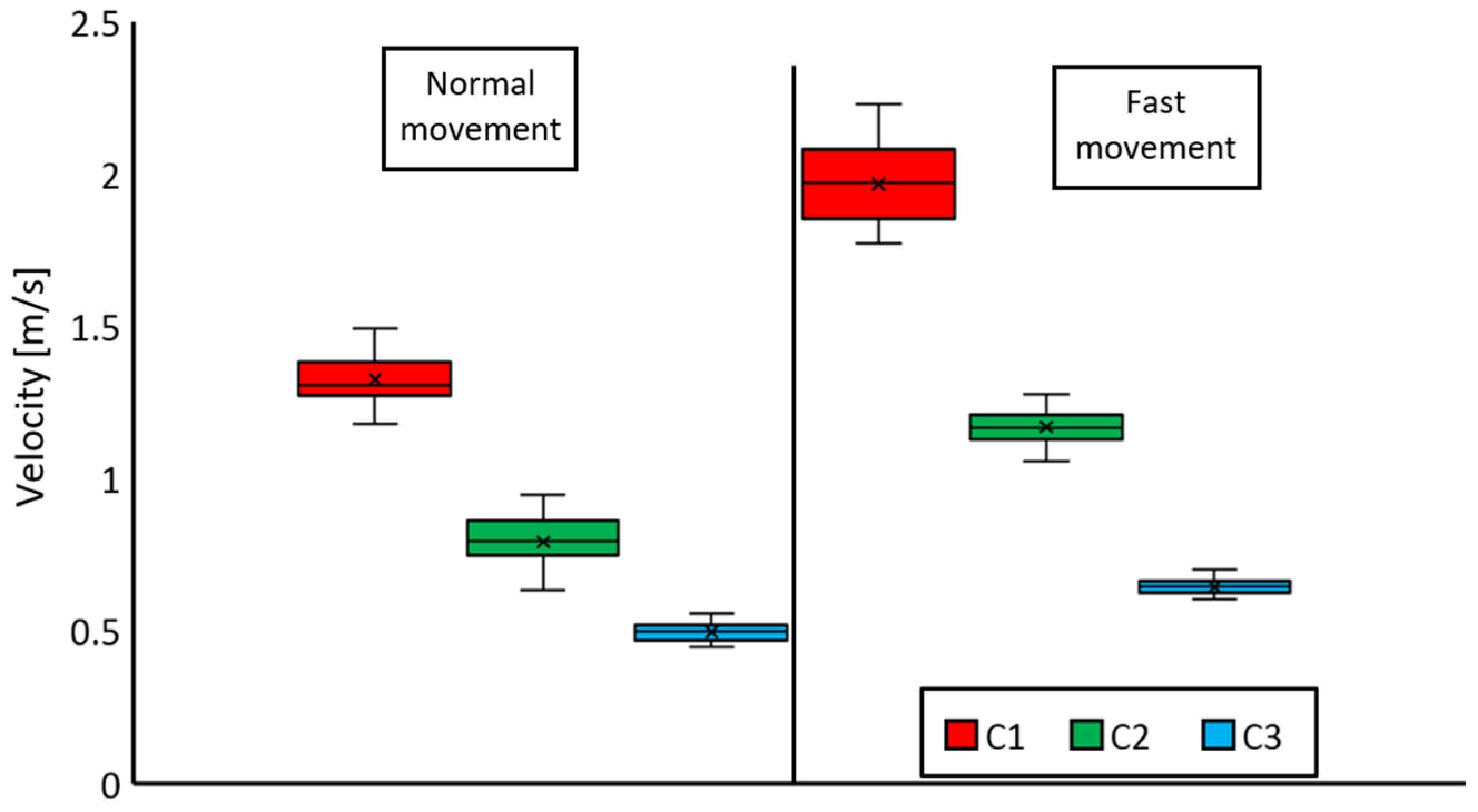



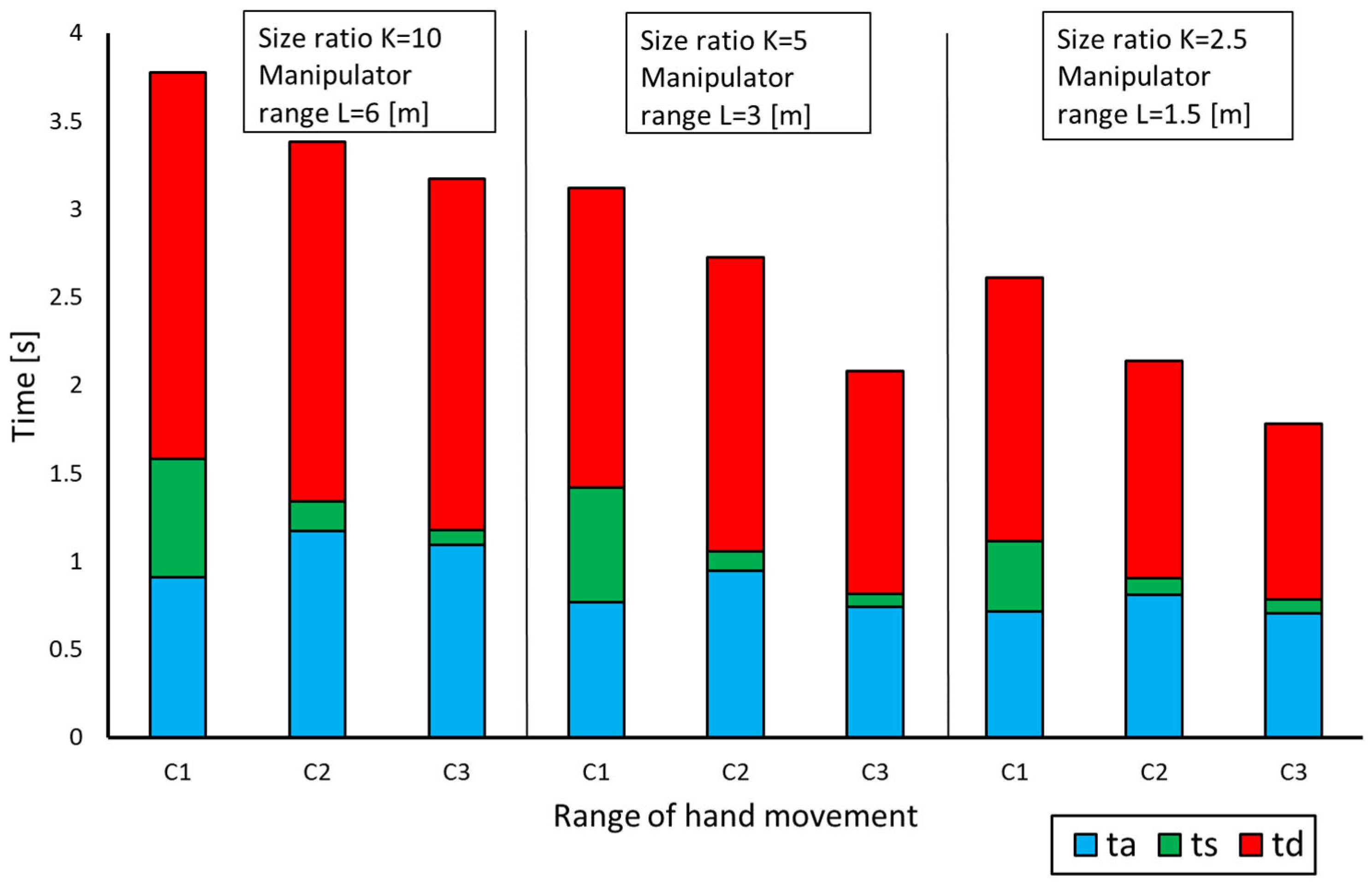


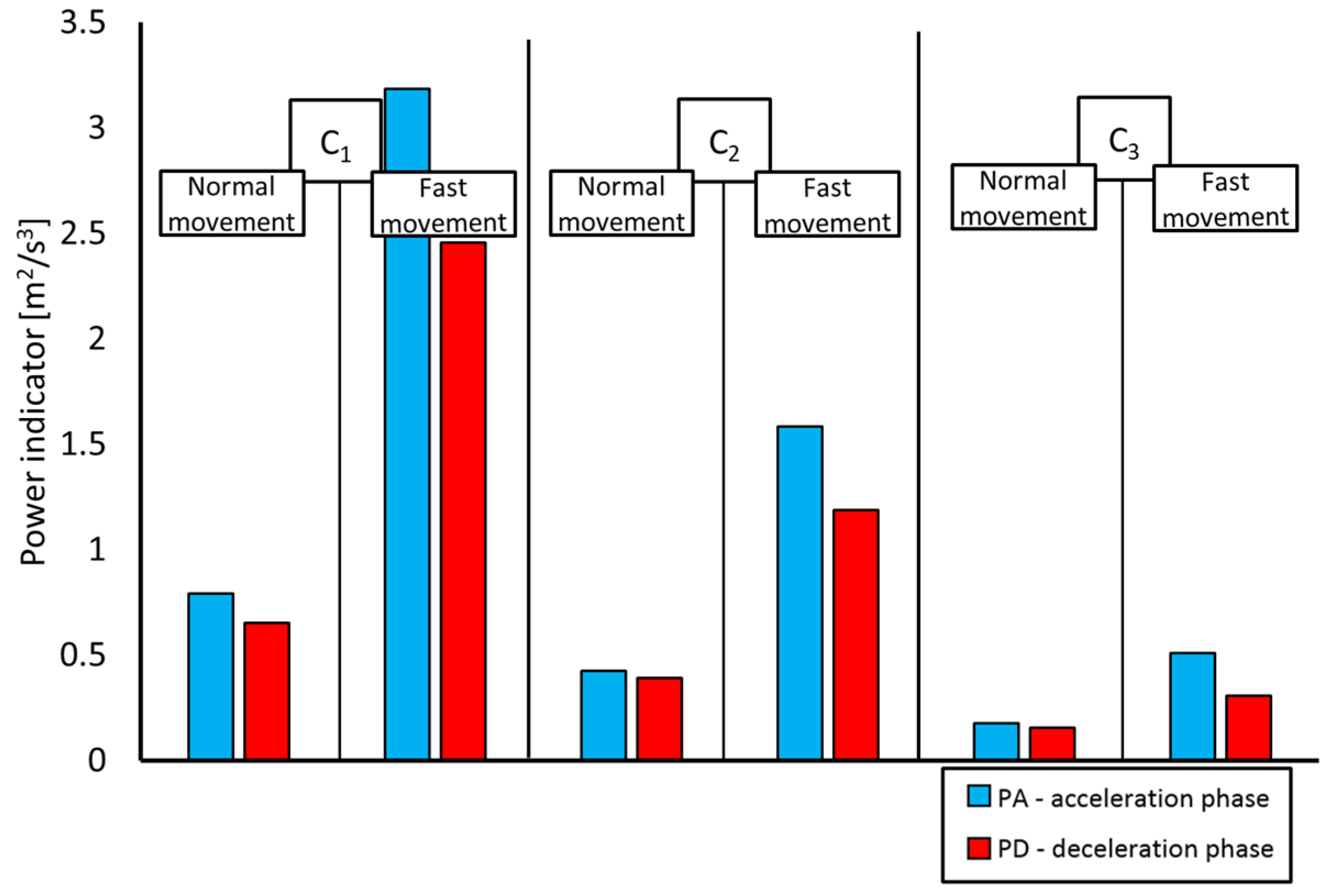
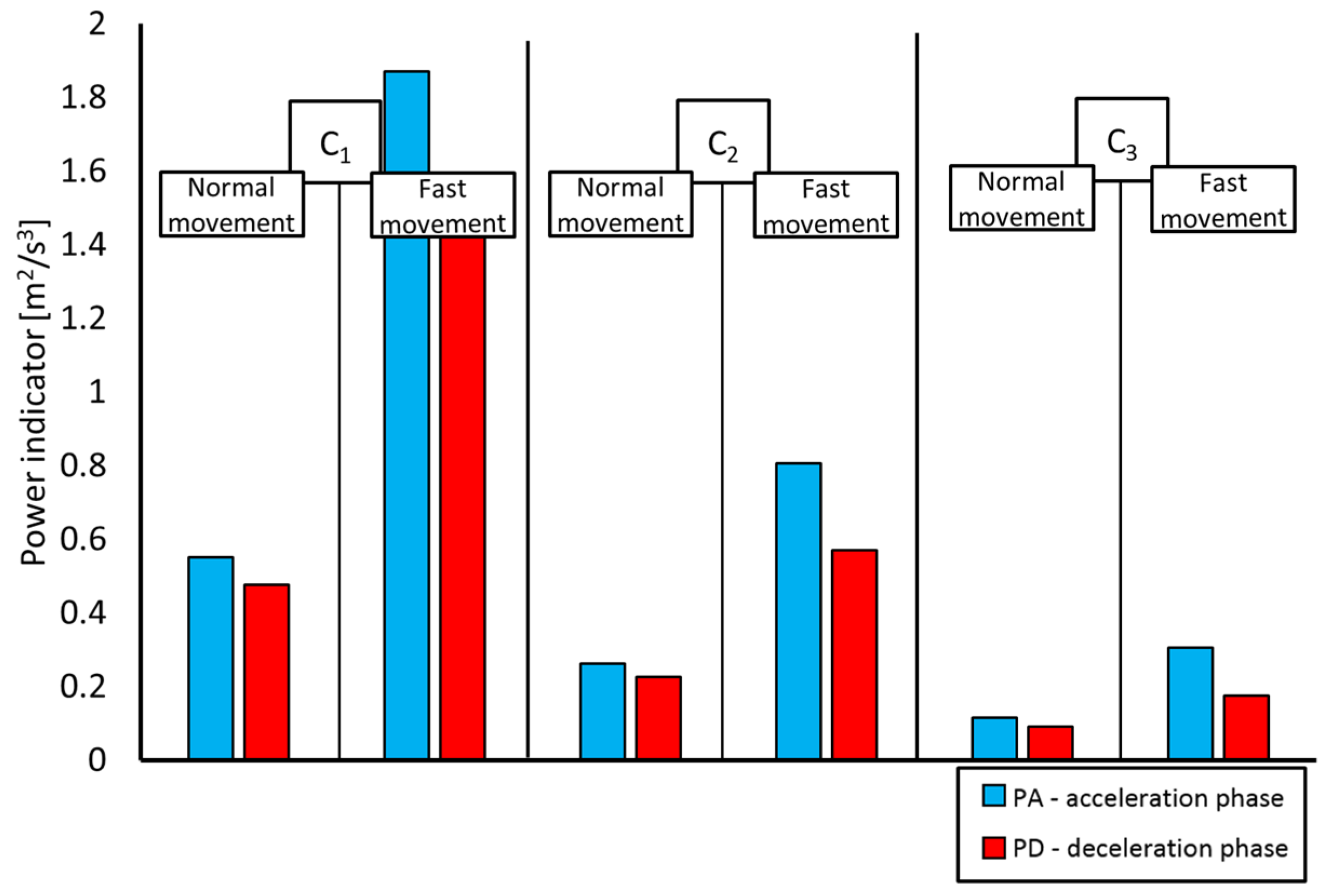
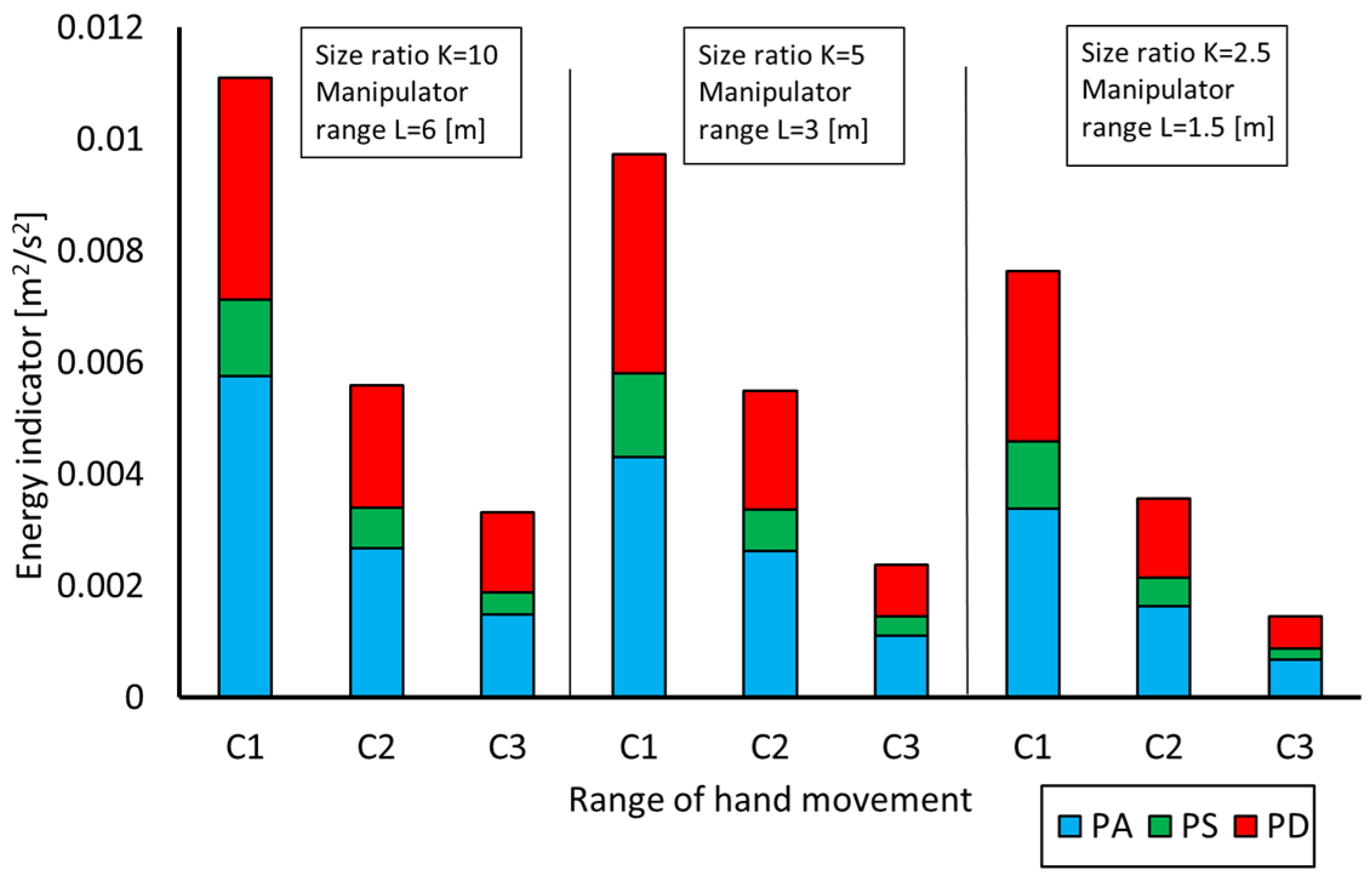
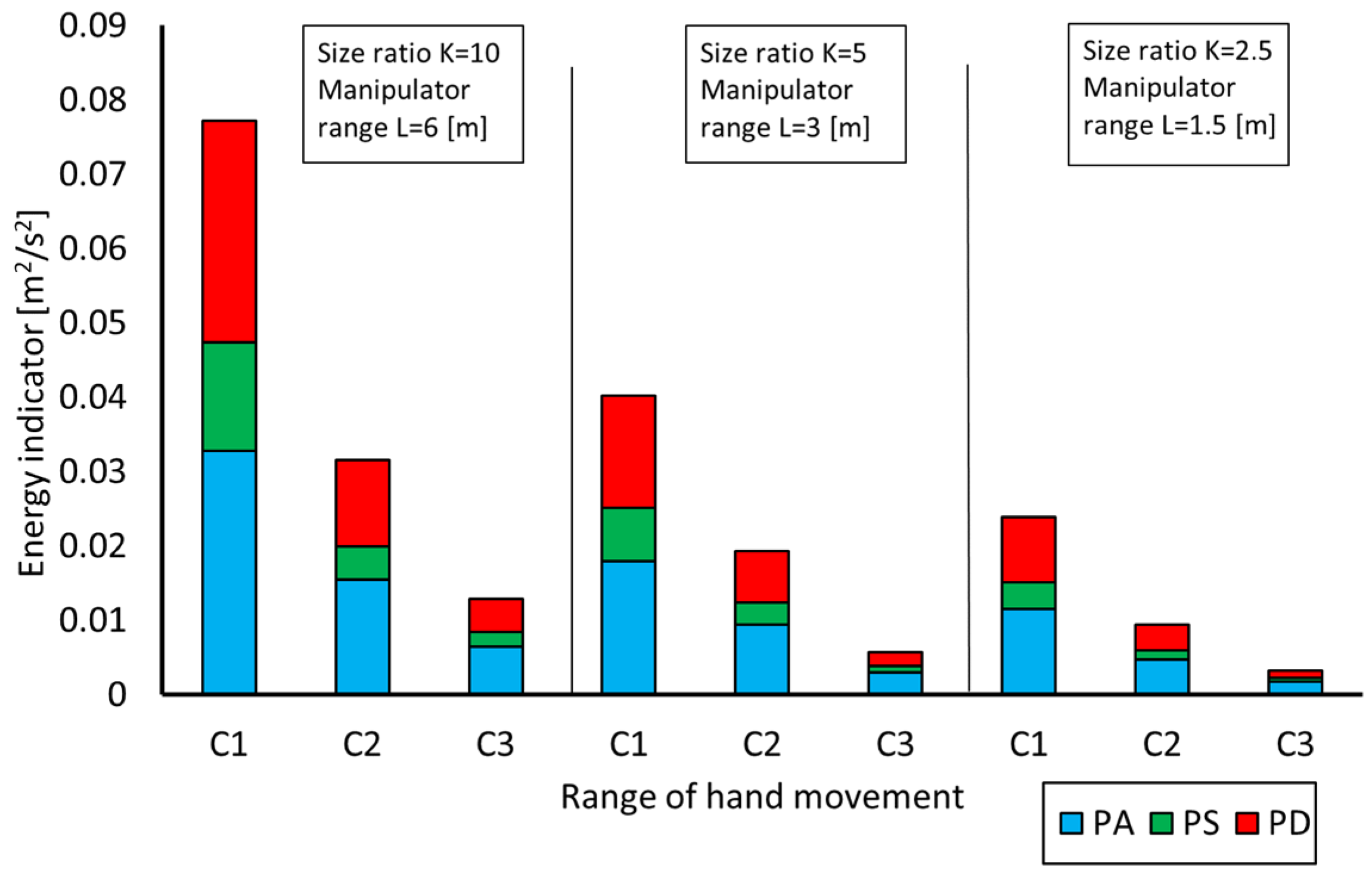
| Parameter Name | Range of Hand Movement |A′B′| [m] | |||
|---|---|---|---|---|
| C1 = 0.8 | C2 = 0.4 | C3 = 0.2 | ||
| Size Ratio K | Manipulator Range L [m] | Effector Displacement |AB| [m] | ||
| ×10 | 6 | 8 | 4 | 2 |
| ×5 | 3 | 4 | 2 | 1 |
| ×2.5 | 1.5 | 2 | 1 | 0.5 |
| Parameter | Fast Movement | Normal Movement | ||||||||||||||||||
|---|---|---|---|---|---|---|---|---|---|---|---|---|---|---|---|---|---|---|---|---|
| K = 10 | K = 5 | K = 2.5 | K = 10 | K = 5 | K = 2.5 | |||||||||||||||
| C1 | C2 | C3 | C1 | C2 | C3 | C1 | C2 | C3 | C1 | C2 | C3 | C1 | C2 | C3 | C1 | C2 | C3 | |||
| PA | aamax | W | 0.94138 | 0.96441 | 0.97154 | 0.97551 | 0.96476 | 0.97634 | 0.98078 | 0.98905 | 0.98001 | 0.9518 | 0.93976 | 0.94628 | 0.92714 | 0.96341 | 0.95022 | 0.95889 | 0.95109 | 0.94857 |
| p | 0.09907 | 0.39945 | 0.58222 | 0.69773 | 0.40724 | 0.72202 | 0.84586 | 0.98548 | 0.82580 | 0.1888 | 0.08961 | 0.00232 | 0.03882 | 0.37737 | 0.17134 | 0.29018 | 0.18076 | 0.01369 | ||
| Namax | W | 0.96545 | 0.98790 | 0.95028 | 0.94882 | 0.97082 | 0.98725 | 0.93295 | 0.99497 | 0.96829 | 0.93509 | 0.93027 | 0.961552 | 0.96728 | 0.94936 | 0.94517 | 0.94541 | 0.9386 | 0.94007 | |
| p | 0.42315 | 0.97595 | 0.17203 | 0.15716 | 0.56172 | 0.96913 | 0.17671 | 0.99993 | 0.49361 | 0.0037 | 0.14824 | 0.00181 | 0.46779 | 0.16253 | 0.12533 | 0.12721 | 0.08339 | 0.09133 | ||
| Ea | W | 0.95353 | 0.97246 | 0.96237 | 0.96599 | 0.95571 | 0.96898 | 0.97411 | 0.98603 | 0.98407 | 0.93047 | 0.94787 | 0.95645 | 0.95711 | 0.93219 | 0.93922 | 0.96119 | 0.92874 | 0.95521 | |
| p | 0.21000 | 0.60837 | 0.35571 | 0.43612 | 0.23980 | 0.51178 | 0.65667 | 0.95339 | 0.92034 | 0.05054 | 0.02726 | 0.03956 | 0.26091 | 0.0358 | 0.01422 | 0.33216 | 0.01851 | 0.23259 | ||
| PD | admax | W | 0.98782 | 0.95114 | 0.94581 | 0.95865 | 0.96120 | 0.98536 | 0.96046 | 0.97909 | 0.97692 | 0.98168 | 0.94798 | 0.92714 | 0.95716 | 0.94087 | 0.9497 | 0.94479 | 0.95231 | 0.93787 |
| p | 0.97515 | 0.18130 | 0.13047 | 0.28591 | 0.33229 | 0.94316 | 0.31818 | 0.80090 | 0.73913 | 0.86835 | 0.14921 | 0.03882 | 0.26164 | 0.09601 | 0.16593 | 0.12246 | 0.19491 | 0.07969 | ||
| Ndmax | W | 0.94736 | 0.97062 | 0.96677 | 0.96539 | 0.95279 | 0.98033 | 0.98972 | 0.96665 | 0.96312 | 0.92799 | 0.9333 | 0.96728 | 0.94451 | 0.93705 | 0.96098 | 0.96372 | 0.95493 | 0.9354 | |
| p | 0.14359 | 0.55617 | 0.45506 | 0.42189 | 0.20067 | 0.83429 | 0.98961 | 0.45211 | 0.37125 | 0.04343 | 0.06014 | 0.46779 | 0.12032 | 0.00411 | 0.32801 | 0.38419 | 0.22873 | 0.01141 | ||
| Ed | W | 0.97833 | 0.96593 | 0.97983 | 0.97292 | 0.97682 | 0.98269 | 0.96044 | 0.97516 | 0.94096 | 0.94293 | 0.937776 | 0.95711 | 0.94573 | 0.94553 | 0.92887 | 0.95956 | 0.96768 | 0.94386 | |
| p | 0.77960 | 0.43468 | 0.82101 | 0.62182 | 0.73612 | 0.89170 | 0.31794 | 0.68739 | 0.12840 | 0.10909 | 0.07915 | 0.26091 | 0.12982 | 0.12824 | 0.02507 | 0.30179 | 0.47771 | 0.1156 | ||
| Movement Type | Size Ratio K | Parameter Name | Range of Hand Movement | ||
|---|---|---|---|---|---|
| C1 | C2 | C3 | |||
| Normal movement | ×10 | vs [m/s] | 0.376 | 0.245 | 0.167 |
| ×5 | vs [m/s] | 0.443 | 0.307 | 0.176 | |
| ×2.5 | vs [m/s] | 0.529 | 0.329 | 0.197 | |
| Fast movement | ×10 | vs [m/s] | 0.719 | 0.436 | 0.237 |
| ×5 | vs [m/s] | 0.743 | 0.474 | 0.241 | |
| ×2.5 | vs [m/s] | 0.795 | 0.488 | 0.258 | |
Disclaimer/Publisher’s Note: The statements, opinions and data contained in all publications are solely those of the individual author(s) and contributor(s) and not of MDPI and/or the editor(s). MDPI and/or the editor(s) disclaim responsibility for any injury to people or property resulting from any ideas, methods, instructions or products referred to in the content. |
© 2024 by the authors. Licensee MDPI, Basel, Switzerland. This article is an open access article distributed under the terms and conditions of the Creative Commons Attribution (CC BY) license (https://creativecommons.org/licenses/by/4.0/).
Share and Cite
Cieślik, K.; Krogul, P.; Łopatka, M.J.; Przybysz, M.; Typiak, R. The Influence of the Operator’s Perception on the Energy Demand for a Hydraulic Manipulator with a Large Working Area. Appl. Sci. 2024, 14, 1800. https://doi.org/10.3390/app14051800
Cieślik K, Krogul P, Łopatka MJ, Przybysz M, Typiak R. The Influence of the Operator’s Perception on the Energy Demand for a Hydraulic Manipulator with a Large Working Area. Applied Sciences. 2024; 14(5):1800. https://doi.org/10.3390/app14051800
Chicago/Turabian StyleCieślik, Karol, Piotr Krogul, Marian Janusz Łopatka, Mirosław Przybysz, and Rafał Typiak. 2024. "The Influence of the Operator’s Perception on the Energy Demand for a Hydraulic Manipulator with a Large Working Area" Applied Sciences 14, no. 5: 1800. https://doi.org/10.3390/app14051800
APA StyleCieślik, K., Krogul, P., Łopatka, M. J., Przybysz, M., & Typiak, R. (2024). The Influence of the Operator’s Perception on the Energy Demand for a Hydraulic Manipulator with a Large Working Area. Applied Sciences, 14(5), 1800. https://doi.org/10.3390/app14051800








